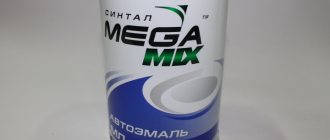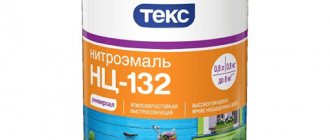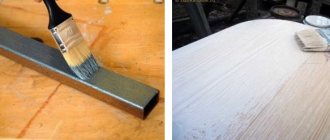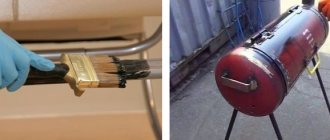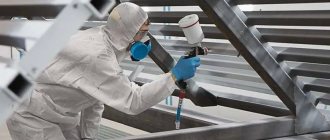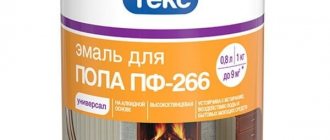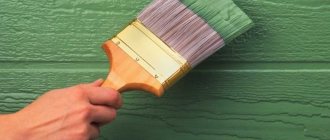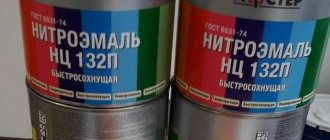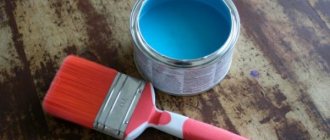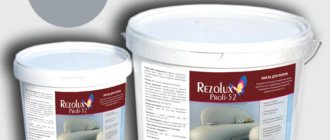This article is intended for direct consumers
PF-115
enamels engaged in painting work.
In the current situation on the Russian market for the supply of popular enamel PF-115
according to
GOST 6465-76
with different price categories are very diverse.
The purpose of the article is to show direct consumers, using real examples, what they actually buy and whether they save money by purchasing cheap “ersatz products according to GOST 6465-76
”.
Our company is not a supporter of the use of any “repressive measures” (proposed by a number of large domestic factories, research institutes and associations in the field of paints and varnishes)
to companies producing, including low-grade paints and varnishes.
In a market economy, no measures will stop manufacturers if there is a demand, in this case, for a “cheap brand” - “PF-115 Enamel GOST 6465-76”
. The result of the introduction of such measures will not be an increase in the quality of coatings, but a fight against small and medium-sized manufacturers and the monopolization of the coatings market within large holdings and associations.
Consumption and application
Pentaphthalic enamel is intended for painting surfaces made of wood, metal, brick, cement and concrete that are exposed to atmospheric influences.
It is also widely applicable for interior decoration of residential and public buildings. The work of PF-115 on metal requires preliminary priming. This will ensure the tightness of the coating, reducing the effect of water and oxygen on the metal, and as a result, the absence of rust formation.
Consumption rate
PF-115 paint per 1 m2 is about 80-100 g. This figure largely depends on the structure and material of the surface, and the method of application. The minimum consumption is achieved when using a roller or brush, the maximum - when using pneumatic spraying.
The density of PF-115 paint varies between 0.9-1.3 g/cm3. The lower this indicator, the thicker the paint, the better the hiding power and the stronger the formed film. But thick paint is more difficult to apply to the surface, so it can be slightly diluted with solvent or white spirit until it is in working condition.
To correctly determine how long PF-115 paint dries
, it is worth considering the type of finishing material and color. All enamels (made according to GOST 6465-76) of the first and highest grade dry to degree 3* at 20 °C for 24 hours, except for red and cherry first grade (48 hours).
*According to laboratory tests, "Grade 3" is when a sheet of paper does not stick to a painted surface when pressed with a 200g weight for 60 seconds.
After the final polymerization of the film (after 6 weeks), the enamel becomes the same coating that is characterized by high hardness, elasticity, impact resistance and stability. Two-layer application of enamel allows you to obtain a dense coating that retains its protective and decorative properties for several years. If the surface is properly prepared and the application technology is followed, the service life of the enamel coating can be about 5 years.
Types of enamel paints
- Alkyd – has high resistance to external influences and washing, maintaining shine for several years;
- Glyphthalic is the same alkyd enamel paint, but unlike the latter, which has a hardening period of 24 hours, it can harden in four times less time;
- Alkyd-melamine - used as a material for spray guns, mainly used for painting vehicle bodies. They have excellent resistance to water and high humidity. Suitable for use in tropical conditions;
- Pentaphthalic is the most common enamel paint used in everyday life. They consist of alkyd components (varnishes), which are modified polyesters of pentaerythritol and phthalic acid. The PF-115 enamel we are considering today belongs precisely to this category.
State standards and additional technical characteristics
PF-115 is an enamel that is manufactured according to state standards 6465-76. Since 2001, some changes have been made to the production rules, but they have not radically affected the application features and composition. The paint base is titanium dioxide and PF-060 varnish. The rest are additives, various pigments and solvents.
For manual and industrial trade, such enamel is made differently. For example, the industrial type of paint is in the form of a concentrate, which must be diluted with a solvent before use. As for paint for retail sale, it contains solvents among the ingredients, and if there is a need to achieve the desired consistency, the mixture can also be diluted.
PF-115 is an enamel that can be represented by paint with different pigments. This affects performance and composition. The color range of the mixture described is quite wide, but limited to primary colors, but there are quite a few shades. If you could not find the desired color in the palette, then you can create it by mixing. For industrial needs, colors are manufactured in factory conditions, which is prescribed in state standards.
Technical characteristics of PF-115
| Indicator name | Meaning |
| Enamel color | Must be within the permissible deviations established by color control samples approved in the prescribed manner |
| Appearance of PF-115 enamel coating | After drying, the enamel should form a smooth, uniform surface without delamination, pockmarks, streaks, wrinkles and foreign inclusions. A small amount of shagreen is allowed. |
| Coating gloss according to photoelectric gloss meter, %, not less: | |
| For colors: red, cherry, black | – |
| Other colors | 60 |
| Conditional viscosity according to a VZ-246 viscometer with a nozzle diameter of 4 mm at a temperature of 20°C, s: | |
| For colors: red, cherry, black | – |
| For other colors | 80-120 |
| Mass fraction of non-volatile substances, %, for enamels: | |
| white, light yellow | 62 — 68 |
| cream, beige, light beige, blue, pistachio, dark gray, blue-gray, gray | 60 — 66 |
| pale yellow, green, dark green, red-brown, yellow, red-orange | 64 — 70 |
| blue, light gray, brown | 57 — 63 |
| black | 49 — 55 |
| red, cherry | 52 — 58 |
| The degree of dilution to a viscosity of 28-30 s using a VZ-246 type viscometer with a nozzle diameter of 4 mm at a temperature of 20°C, %, no more | 20 |
| Degree of grinding, microns, no more, enamels: | |
| PF-115 white enamel | 10 |
| PF-115 red enamel | 25 |
| PF-115 cherry enamel | 25 |
| PF-115 black enamel | 25 |
| PF-115 paint in other colors | 15 |
| Covering capacity of the dried film, g/m2, no more, for PF-115 enamels of the following colors: | |
| white | 60 |
| pale yellow | 95 |
| light yellow | 90 |
| creamy | 85 |
| red-orange | 50 |
| beige | 55 |
| light beige | 65 |
| pistachio, gray, green, blue | 50 |
| yellow | 35 |
| gray-blue | 40 |
| dark gray, red-brown, blue | 55 |
| brown | – |
| dark green | – |
| red | – |
| cherry | 80 |
| black | – |
| light gray | |
| Film elasticity when bending, mm, no more | 1 |
| Film strength when impacted by a U-1 type device, cm, not less, enamels: | |
| PF-115 red, cherry, black | – |
| PF-115 other colors | 50 |
| Film adhesion, points, no more | 1 |
| Coating hardness according to a pendulum device, not less than: TML type (pendulum A), relative units, for enamels: | |
| red, cherry | 0,10 |
| black | 0,10 |
| white | – |
| other colors | 0,35 |
| Resistance of the coating at a temperature of 20°C to the static effects of water, hours, not less, for enamels: | |
| red, cherry, black | – |
| other colors | 10 |
| Resistance of the coating to static effects of 0.5% detergent solution, min, not less | 15 |
| Resistance of the coating at a temperature of 20°C to the static effects of transformer oil, h, not less | 24 |
3. TEST METHODS
3.1. Sampling - according to GOST 9980.2.
3.2. Preparing samples for testing
The preparation of plates for applying enamel is carried out in accordance with GOST 8832, section 3. The drying time of the film is determined on plates made of black tin according to GOST 13345 with a size of 70150 mm and a thickness of 0.25-0.32 mm or steel grades 08 kp and 08 ps with a size of 70150 mm and a thickness of 0.7-1.0 mm according to GOST 16523. The elasticity of the film during bending is determined on plates made of black tin according to GOST 13345 with a size of 20150 mm and a thickness of 0.25-0.32 mm. The hardness and gloss of the coating is determined on glass plates measuring 90-120 mm, thickness from 1.2 to 1.8 mm. The remaining indicators are determined on plates made of steel grades 08 kp and 08 ps with a size of 70150 mm and a thickness of 0.7-1.0 mm according to GOST 16523. Conditional viscosity, mass fraction of non-volatile substances and the degree of grinding are determined in undiluted enamel. When determining the color, appearance, gloss of the coating, drying time, elasticity of the film when bending, strength of the coating on impact, hardness, resistance of the coating to the static effects of water, detergent solution and transformer oil, film adhesion, the test enamel is diluted with a mixture of solvent and white spirit (nefrasa-S4-155/200) 1:1, with solvent or xylene to a conditional viscosity of 28-30 s using a VZ-246 viscometer with a nozzle diameter of 4 mm at a temperature of (20.0±0.5) °C, filtered through a mesh N 01N-02N according to GOST 6613 and applied to the prepared plates with a paint sprayer in one layer (except for color determination). When determining the color, the enamel is applied until the surface to be painted is completely covered. Drying of cherry and red enamel films is carried out at a temperature of (20±2) °C for 48 hours, for other colors - for 24 hours (except for determining the hardness of the coating of PF-115 enamels). When determining the hardness of the coating of PF-115 enamels, drying is carried out at a temperature of (20±2) °C for 48 hours. To determine the resistance of the coating to the static effects of water, detergent solution and transformer oil, the enamel is applied to both sides of the plate.
The thickness of the coating after drying for black, red and cherry enamels should be 13-18 microns, for other enamels - 18-23 microns. (Changed edition, Amendment No. 1, 3, 4, 5).
3.3. The color of the enamel coating is determined visually according to GOST 29319. In case of disagreement in color assessment, the determination of color in natural daylight is taken as the final result.
3.4. The appearance of the enamel coating is determined visually in natural diffused light.
3.3, 3.4. (Changed edition, Amendment No. 5).
3.4a. (Deleted, Amendment No. 5).
3.4b. The mass fraction of non-volatile substances is determined according to GOST 17537. A sample of the tested enamel weighing (2.0±0.2) g is placed in a drying oven and maintained at a temperature of (140±2) °C. The first weighing is carried out after 1.5 hours of exposure in the cabinet, subsequent weighings are carried out every 30 minutes until a constant weight is reached. It is allowed to determine the mass fraction of non-volatile substances under an infrared lamp at a temperature of (140±2) °C. In case of disagreement in the assessment of the mass fraction of non-volatile substances, the determination in the drying cabinet is taken as the result. (Introduced additionally, Amendment No. 3).
3.5. Determining the degree of enamel dilution
3.5.1. Carrying out the test 120-130 g of the tested enamel is weighed, recording the weighing result accurate to the second decimal place, diluted with a mixture of solvents, solvent and white spirit (Nefrasa-S4-155/200) 1:1, xylene or solvent to a working viscosity of 28-30 s using a VZ-246 type viscometer with a nozzle diameter of 4 mm at a temperature of (20.0±0.5) °C. (Changed edition, Amendment No. 4, 5).
3.5.2. Processing of results Dilution degree ( X
) as a percentage is calculated by the formula where
m1
is the mass of solvent used to dilute the enamel, g;
m
—mass of enamel, g.
3.6. The hiding power is determined according to GOST 8784 at an enamel viscosity of 20-22 s at a temperature of (20.0±0.5) °C using a VZ-246 viscometer with a nozzle diameter of 4 mm. The enamel is applied with a paint sprayer. Drying time to degree 3 is in accordance with Table 1. (Changed edition, Amendment No. 5).
3.6a. Before determining adhesion, the samples are kept at a temperature of (20±2) °C and relative air humidity (65±5)% for 3 hours (Introduced additionally, Amendment No. 4).
3.6b. Determination of coating hardness
3.6b.1. The hardness of the enamel coating is determined according to GOST 5233, section 1.
3.6b.2. Determination of coating hardness using a pendulum device type M-3.
3.6b.2.1. Equipment and materials Pendulum device type M-3 for determining hardness at room temperature (20±2) °C (drawing).
1
- trigger mechanism;
2
- base;
3
- scale;
4
— installation screws;
5
— cargo;
6
— two-hand mechanism;
7
- tripod;
8
— connecting strip;
9
— frame;
10
- table;
11
— steel balls;
12
- plumb line
Main characteristics of the pendulum device: pendulum mass (120±1) g; length of the pendulum, counting from the fulcrum to the end of the arrow, (500±1) mm; diameter of the steel ball (fulcrum) 7.938 mm according to GOST 3722; instrument scale divided into degrees; deflection angle from 5° to 2°; damping time of oscillations on a glass plate (“glass number”) (440±6) s. Glass plates measuring 90-120 mm, thickness from 1.2 to 1.8 mm. Stopwatch. Solvents: ethyl ether according to GOST 8981 or technical acetone according to GOST 2768.
3.6b.2.2. Preparation for testing Before each test, the pendulum balls and the glass plate of the device are thoroughly wiped with cotton wool soaked in solvent, and then with dry, clean gauze. The test enamel is applied to the plates prepared in accordance with GOST 8832 (clause 3.2).
3.6b.2.3. Carrying out the test The pendulum device is checked by the “glass number” - the damping time of the oscillations of the pendulum, the fulcrum of which lies on the glass plate of the device. The determination of the “glass number” is carried out at a temperature of (20±2) °C and relative air humidity (65±5)%. Measurements are carried out on at least three areas of the surface of the glass plate. In the same way, the decay time of the pendulum oscillations on a glass plate with the enamel coating being tested is determined.
3.6b.2.4. Processing of results Hardness ( H
), conventional units, are calculated using the formula where
t
is the decay time of the pendulum oscillations on the tested enamel coating, s;
t1
is the damping time of the pendulum oscillations on the glass plate of the device (“glass number”), s. The test result is taken as the arithmetic mean of the obtained results of measuring the decay time of the pendulum oscillations on the glass plate and on the test sample of the enamel coating. The deviation of the values of individual measurements from the arithmetic mean should not be more than 3%. In case of disagreement, the “coating hardness” indicator is determined according to GOST 5233, using a TML type pendulum device (pendulum A).
3.6b.2.5. Error of the method The error of the method when determining hardness on the M-3 device is ±0.02 conventional units.
3.6b-3.6b.2.5. (Introduced additionally, Amendment No. 5).
3.7. To determine the resistance of the coating to the static effects of water, painted and dried samples are kept in air before testing for 5 days, then the samples are placed at 2/3 of the height in distilled water (GOST 6709) and kept for the time specified in paragraph 14 of the table. 1. After testing, the samples are kept in air at a temperature of (20±2) °C for 1 hour and the appearance of the coating is examined. The enamel coating should remain unchanged in appearance. A slight change in the color of the coating is allowed.
3.8. To determine the resistance of the coating to the static effects of a detergent solution, painted and dried samples are kept in air before testing for 2 hours, then the samples are placed at 2/3 of the height in a 0.5% solution of a synthetic detergent powder according to GOST 25644, at a temperature 30 °C - 40 °C, and kept in solution at a given temperature for 15 minutes. After testing, the samples are kept in air at a temperature of (20±2) °C for 1 hour and the appearance of the coating is examined. The enamel coating should remain unchanged in appearance.
3.7, 3.8. (Changed edition, Amendment No. 3, 4, 5).
3.9. (Deleted, Amendment No. 5).
3.10. To determine the resistance of the coating to the static effects of transformer oil, painted and dried samples are kept in air before testing for 5 days, then the samples are placed at 2/3 of the height in transformer oil (GOST 982) at a temperature of (20±2) °C and kept in oil for the time specified in clause 16 of table 1. After testing, the samples are kept in air at a temperature of (20±2) °C for 2 hours and the appearance and color of the coating are examined. A slight change in the color of the coating is allowed. (Introduced additionally, Amendment No. 4).
SAFETY REQUIREMENTS
6.1. PF-115 enamels of various colors are fire hazardous and toxic materials, which is due to the properties of the components included in their composition.
Maximum permissible concentrations, hazard classes of components according to GOST 12.1.005 and fire hazard characteristics according to GOST 12.1.044 are given in table. .
table 2
| Maximum permissible concentration of vapors in the air of the working area of industrial premises, mg/m3 | Hazard Class | Temperature, C | Concentration limits of ignition,% (by volume) | |||
| flashes | spontaneous combustion | lower | upper | |||
| Xylene | 50 | 3 | Not lower than 23 | Above 450 | 1,0 | 6.0 |
| Turpentine | 300 | 4 | 34 | 300 | 0,8 | 6.9 |
| White Spirit | 300 | 4 | Not lower than 33 | 270 | 1,4 | 6.0 |
| Solvent | 50 | 3 | 22-36 | 464-535 | 1,02* | — |
| Lead compounds | 0,01/0,005 | 1 | — | — | — | — |
| Chromium compounds | 0,01 | 1 | — | — | — | — |
* Lower flammability limit at a temperature of 25 ° C and a pressure of 101325 Pa (760 mm Hg).
Solvent vapors have an irritating effect on the mucous membranes of the eyes, upper respiratory tract and skin.
Lead compounds, being extremely dangerous, cause chronic intoxication, expressed in damage to the central nervous and cardiovascular systems, changes in the blood, gastrointestinal tract and other organs.
Chromium compounds irritate and cauterize the mucous membrane and skin, causing ulceration; When aerosols are inhaled, the cartilaginous part of the nasal septum is perforated. They also have a general toxic effect, affecting the gastrointestinal tract.
6.3. The production of enamels must comply with the safety rules for paint and varnish production, approved in accordance with the established procedure.
6.4. Production, testing and use of enamels must comply with the requirements of GOST 12.3.005 and GOST 12.1.004.
6.5. Persons associated with the production and use of enamels must be provided with special clothing in accordance with GOST 12.4.103 and personal protective equipment in accordance with GOST 12.4.011, GOST 12.4.068.
Personal respiratory protection equipment - in accordance with GOST 12.4.028, GOST 12.4.004 and GOST 17269.
6.6. Work related to the production and use of enamels is carried out in rooms equipped with local and general supply and exhaust ventilation in accordance with GOST 12.4.021, ensuring the condition of the air environment in accordance with GOST 12.1.005.
Fire extinguishing agents - sand, felt, foam fire extinguishers OHP-10, carbon dioxide fire extinguishers OU-2 and OU-5, foam installations, finely sprayed water - in accordance with GOST 12.4.009.
6.7. To protect the atmospheric air from pollution, air purification must be provided at gas treatment plants and monitoring compliance with maximum permissible emissions (MPE) in accordance with GOST 17.2.3.02.
6.8. Waste generated during equipment cleaning is disposed of in accordance with the procedure for accumulation, transportation, neutralization and disposal of toxic industrial waste.
Sec. 6. (Changed edition. Amendment No. 5).
4. PACKAGING, LABELING, TRANSPORTATION AND STORAGE
4.1. Packaging of enamels is in accordance with GOST 9980.3. (Changed edition, Amendment No. 4).
4.2. Marking of enamels is in accordance with GOST 9980.4*. ________________ * The document is not valid on the territory of the Russian Federation. GOST 9980.4-2002 is in force. — Note from the database manufacturer. The transport container must be marked with: danger sign according to GOST 19433 (class 3), classification code 3313, UN number 1263.
4.3. Transportation and storage - according to GOST 9980.5*. ________________ * The document is not valid on the territory of the Russian Federation. GOST 9980.5-2009 is in force. — Note from the database manufacturer. During storage, the nominal viscosity of enamels increases from the norm according to Table 1. When diluting enamels with a solvent in an amount of no more than 10% (by weight of the enamel) to the standard for the “viscosity” indicator, the enamels must comply with the requirements of this standard.
4.2, 4.3. (Changed edition, Amendment No. 4, 5).
Peculiarities
To begin with, it is worth noting that it is more correct to call PF-115 enamel enamel paint, since there is a certain difference between these concepts. Enamel provides a stronger and smoother film on the surface than oil or alkyd paints.
Enamel paints come in several varieties:
- alkyd;
- pentaphthalic;
- glyphthalic;
- alkyd-melamine;
- alkyd-phenolic and alkyd-oil.
Pentaphthalic type of enamels is considered the most common and widely used in everyday life. In this group of paints and varnishes you can find a composition suitable for different types of surfaces (wood, concrete, metal, brick, chipboard, fiberboard, asbestos cement, plaster, oil or other paint, etc.). The color range of such enamels is truly limitless: the finished coating can be matte, semi-matte or glossy.
Enamel combines well with other types of finishing materials. This significantly expands the scope of its use. From an economy class material, it easily turns into an ideal option for decorating the most modern, original and fashionable interiors.
PF-115 enamel has proven itself and continues to hold a leading position among similar materials due to its impeccable performance and high decorative characteristics. Paint allows you not only to create a beautiful, smooth, shiny, glossy or discreet matte layer, but also to give the surface additional resistance to external influences, humidity, temperature changes, etc.
The popularity of this coloring composition has led to the fact that today not only large factories, but also very small companies are engaged in the production of this modification. Different types of enamels from this group have different alphanumeric designations that determine their properties and characteristics:
- the abbreviation “PF” denotes belonging to the pentaphthalic group of enamels;
- the first digit “1” indicates that the composition is intended for outdoor use;
- “15” is the serial number of the composition in the catalogue.
To get a complete picture of this material, it is necessary, first of all, to evaluate its advantages and disadvantages.
PF-115 enamel has a huge number of positive characteristics.
- Affordable price. An important factor when it comes to choosing a finishing material for a large amount of work or inexpensive repairs.
- Possibility of use for external and internal work. This means that the composition is moisture resistant, it is not afraid of UV rays, aggressive climatic conditions, temperature changes, etc. The enamel perfectly retains its performance characteristics in the range from -50 to +60°C.
- Wide range of colors. In addition, if it is necessary to obtain a certain shade, the enamel can be tinted perfectly at home.
- Easy to apply. The coloring composition is easily and quickly applied with different types of tools.
- Wear resistance. Enamel forms a fairly strong film on the surface that is resistant to mechanical stress.
- Protecting surfaces from mold and mildew.
- Durability.
- Corrosion protection.
- Resistant to gasoline and oils.
- Resistance to mineral fertilizers.
- Detergent resistant.
However, even this popular type of enamels is not without a number of disadvantages.
- The composition takes a long time to dry (24 hours). This point can be fundamental in some cases when it is necessary to paint and dry the surface very quickly.
- PF-115 enamel has a distinct, specific odor (not very strong, but quite noticeable for people prone to allergies).
- The enamel coating is very difficult to remove from hands and dirty instruments. Typically, builders prefer to throw away used paint brushes and rollers rather than bother with cleaning them.
- The material is toxic and fire hazard.
- Before applying enamel, it is necessary to pre-prime the surface to be treated.
Painting
The universal qualities of PF-115 allow you to paint the surface at air temperatures from 5 to 35 degrees Celsius. To apply paint, use brushes, brushes, rollers or spray guns. Immersion dyeing is also used.
Metal structures are painted with at least two layers of enamel after preliminary priming. For high-quality painting of wood, brick, concrete or plaster, you will need two or three layers with a thickness of 18–23 microns each. The variation in thickness is due to differences in the structure of the material being painted and the color of the paint.
After applying the enamel layer, the surface must dry. Drying at a temperature of 20 degrees takes up to 24 hours. When faster drying is needed, high temperatures (100–110 degrees) can be used.
After the enamel dries, the surface becomes glossy, uniform, and smooth. It is resistant to friction, atmospheric and chemical influences. PF-115 is compatible with almost any type of paint and varnish coating.
Surface preparation
Before applying the enamel, it is necessary to carry out preparatory measures so that the paint layer lays down well.
The work is performed in this order:
- Remove traces of grease, dirt, and old paint from the surface. To do this, you can use washing powder, soap or soda solution. Treat wooden materials with sandpaper. Remove traces of rust from metal structures.
- Dry the surface thoroughly (especially if we are talking about plaster or concrete).
- If metal is to be painted, treat it with a degreasing compound and apply an anti-corrosion primer.
- If wood will be covered with enamel, apply drying oil, Biotex primer or universal varnish.
- For porous surfaces, an alkyd primer is preferable.
Rules for applying primer:
- Dilute the composition with a solvent (if necessary according to the instructions).
- Stir the mixture with a wooden stick.
- Apply a thin layer of primer using a brush or roller.
- Allow the surface to dry.
Note! Pentaphthalic primers can be applied over old paint. However, then you need to sand its layer
Security measures
Painting should be carried out only with the use of personal protective equipment (goggles, gloves, respirator). If paint and varnish material gets on the skin, wash the affected area with warm soapy water. When carrying out work, good natural or artificial ventilation must be provided. There should be no sources of fire near the area to be painted.
Enamel consumption
One of the advantages of PF-115 is its economical consumption. Specific indicators depend on many circumstances:
- Method of application. When working with a sprayer, the paint and varnish material is consumed less economically compared to using a brush.
- Manufacturing technology. PF-115 is produced not only according to GOST, but also according to specifications. In the latter case, the consumption is approximately 50% higher.
- Degree of foundation preparation. A well-primed surface reduces the consumption of paints and varnishes.
- Consumption per 1 m2 even depends on the color of the enamel. The most economical option is black paint, and the most wasteful is white. Other colors occupy an intermediate position.
- Type of material to be painted. The consumption per 1 m2 of metal will be less than when painting wood, which absorbs part of the paintwork.
Enamel consumption is from 100 to 180 grams per square meter of one layer.
Technological process of applying PF-115 enamel
Depending on the type of surface, painting technology may be different.
Metal painting
. First of all, it is necessary to mechanically remove rust, and treat the remaining corrosion defects with an inhibitor. After this, the surface is treated with primer GF-0119 or a similar composition. Painting is done in two layers with an interval of 24 hours.
Wood staining
. PF-115 enamel, the main technical characteristics of which are completely suitable for painting surfaces made of natural wood, is applied in 2-3 layers depending on the absorbency of the material; the use of primers, in this case, is optional. Pre-treatment with antiseptic compounds compatible with pentaphthalic enamels is possible.
Painting plaster, brick and concrete
. To obtain a high-quality coating, 2-3 layers are needed. Before applying enamel, it is advisable to use antiseptic compounds to prevent the appearance of fungus and mold. The relative humidity of the surfaces to be painted should be between 10 and 15%.
How to paint correctly with PF 115 paint video
During painting work, PF 115 paint must be stirred regularly to prevent the formation of sediment.
APPENDIX 3 Information
| Indicator name | Norm |
| 1. Specific volumetric electrical resistance, Ohm×m | 5 ´ 104 — 1 ´ 104 |
| 2. Dielectric constant | 6-11 |
APPENDIX 3.
(Changed edition. Amendment No. 5).
INFORMATION DATA
1.
DEVELOPED AND INTRODUCED by the Ministry of Chemical Industry of the USSR
2.
APPROVED AND ENTERED INTO EFFECT by Resolution of the USSR State Committee on Standards
Change No. 5 adopted by the Interstate Council for Standardization, Metrology and Certification (Minutes No. 20 of 01.11.2001)
Registered by Bureau of Standards MGS 3975
The following voted to approve the change:
| State name | Name of the national standardization body |
| The Republic of Azerbaijan | Azgosstandart |
| Republic of Armenia | Armgosstandard |
| Republic of Belarus | State Standard of the Republic of Belarus |
| The Republic of Kazakhstan | Gosstandart of the Republic of Kazakhstan |
| Republic of Kyrgyzstan | Kyrgyzstandard |
| The Republic of Moldova | Moldova-Standard |
| Russian Federation | Gosstandart of Russia |
| The Republic of Tajikistan | Tajikstandard |
| Turkmenistan | Main State Service "Turkmenstandartlary" |
| The Republic of Uzbekistan | Uzgosstandart |
| Ukraine | State Standard of Ukraine |
3.
INSTEAD OF GOST 6465-63 and GOST 5.820-71
4.
REFERENCE REGULATIVE AND TECHNICAL DOCUMENTS
| Designation of the referenced technical document | Number of paragraph, subparagraph | Designation of the referenced technical document | Number of paragraph, subparagraph |
| ; | , | ||
| ; | |||
| , | |||
| ; ; |
6.
The validity period was lifted according to Protocol No. 5-94 of the Interstate Council for Standardization, Metrology and Certification (IUS 11-12-94)
7.
EDITION (May 2004) with Amendments No. 1, 2, 3, 4, 5, approved in January 1979, June 1980, June 1985, April 1988, May 2002 (IUS 3-79, 8-80, 10-85, 7-88, 8-2002)
2. ACCEPTANCE RULES
2.1. Acceptance rules - according to GOST 9980.1. (Changed edition, Amendment No. 4).
2.2. Acceptance tests are carried out according to indicators 1-5, 7-9, 12 of Table 1. If unsatisfactory results of acceptance tests are obtained for at least one of the indicators, repeat tests are carried out on a double sample taken from the same batch. The test results apply to the entire batch. Standards for indicators 6, 13, 14, 15 and 16 of Table 1 are determined at least once a year from the calendar date of the start of enamel production. Standards for indicators 10 and 11 of Table 1 are determined in every thirtieth batch. If unsatisfactory results of periodic tests are obtained, each batch is checked until satisfactory results are obtained in a row for at least three batches. If a repeated negative result is obtained, periodic tests are transferred to acceptance tests until satisfactory results are obtained. (Changed edition, Amendment No. 4, 5).
note
Due to the fact that PF-115 enamel contains toxic components and is a fire hazard, it is important to take precautions when working with this type of paint. Use personal protective equipment
To prevent the odor released before the enamel dries from being absorbed into textiles and furniture, before painting, if possible, it is recommended to empty the room of them.
The enamel coating after drying has no harmful effects on people, animals and the environment.
Produced by order and under the control of Tech-Color LLC.
Supplier: Tech-Color LLC, 625014, Tyumen, st. Republic, 256, building 2.
If you have any questions, please write to Thank you.
Precautionary measures
When working with alkyd enamels, in particular with PF 115, the following precautions must be observed:
- The paint should be stored in airtight packaging;
- Take measures to ensure fire safety;
- Carry out painting work with protective rubber gloves;
- Avoid inhaling enamel fumes;
- After completion of work, ensure thorough ventilation of the room for 2-3 days.
Taking into account the above facts, we can conclude that alkyd enamel PF-115, developed in the USSR back in the 70s of the twentieth century, has not yet lost its relevance. The ability to use when painting any surface, the high quality and appearance of the resulting protective and decorative coatings ensured the wide popularity of the paint among the average consumer.
Video demonstration of removing PF-115 enamel using RIPAG remover
In addition, the favorable price/quality ratio allows domestic alkyd enamels to successfully compete with leading foreign manufacturers.
Advantages and disadvantages of enamel
This paint coating is sold at very affordable prices, which makes it possible to use it even for large-scale exterior painting work. Due to its composition, this paint is extremely resistant to moisture, precipitation, solar radiation, detergents and industrial oils. The temperature at which this material retains its properties varies from +60 to -50 degrees Celsius. In temperate climates, properly applied paintwork lasts up to 4 years. The tropical climate reduces this period to 1 year. In addition, the enamel adheres well to primer, metal and wooden surfaces.
The disadvantages include the relatively long drying time, the smell, which not everyone likes, and the difficulty of washing off painting tools. Many people, having never washed their paint brushes after it, prefer to throw them away. In this case, the paint belongs to the category of toxic and fire hazardous substances.
How to distinguish low-quality enamel PF-115
The manufacturing quality of this type of enamel paint is regulated by GOST 6465-76. In order to be confident in all the parameters regulated by GOST, it is best to take paint with a price of more than 65 rubles per kilogram. On the contrary, options cheaper than 40 rubles are not even worth considering, since they are fake. You can recognize the latest, or simply poorly made enamel, by the following signs:
- Strong odor of white spirit. Despite the fact that the latter is present in all types of this enamel, too strong a smell may indicate low quality;
- No film even after long-term outdoor storage;
- The coating remains sticky for a long time even at elevated temperatures.
As a rule, all complaints about PF-115 enamel regarding its long drying time and high consumption are associated with the initial purchase of low-quality material in dubious places.
Why enamel paint and not enamel
At the beginning of the article, it was not for nothing that we separated these two concepts. After all, enamel and enamel paint are different things that should not be confused. In general, enamel does not belong to the category of paint at all, representing a thin layer of glassy coating. Most often we are talking about white options, such as glazes. So PF-115 is precisely an enamel paint, which, unlike oil (drying oil), powder and water-dispersion options, is distinguished by a coating that is more smooth and durable. The term “enamel” itself in this case is only colloquial.
Compound
The basic composition of PF-115 enamel includes:
- semi-finished pentaphthalic varnish;
- titanium dioxide;
- White Spirit;
- coloring pigments and fillers.
However, this composition may vary depending on the final color. For example, to obtain blue enamel, zinc white and iron glaze are added to the composition, and carbon black is used to create a gray color.
The production of enamel is carried out in accordance with the requirements of GOST 6465-76, to which minor changes were made in 2001, which did not radically affect the components of the composition and their percentages.
The purpose of the adjustments being made is to reduce the cost of the product, but it is worth keeping in mind that enamel that is not made to the original standards is somewhat inferior in quality to the original product.
It should be noted that the enamel offered for domestic and industrial needs is somewhat different. The second option involves a concentrated composition that requires mandatory dilution before use. Household pentaphthalic alkyd paint is ready for use. However, if necessary, it can also be diluted with a solvent.
On store shelves today you can find two varieties of PF-115 enamel: “Economy” and “Standard”. The difference between them is cost and quality. “Standard” enamel has better hiding power, creates a beautiful, durable, even film on the surface, and is more resistant to adverse weather conditions.
Composition and marking of PF-115 paint
High-quality enamel must meet all the requirements of GOST 6465-76. The PF marking indicates that the binding element of the enamel is pentaphthalic varnish, which is a modification of alkyd resin. Index 115 determines the area of paint use.
- Number 1 indicates that the enamel can be used for exterior painting in a wide climatic range;
- Index 15 is the serial number of the chemical compound used, the composition of which is regulated by the relevant GOST.
From a physical point of view, PF-115 enamel is a suspension consisting of dyes, titanium dioxide, pigments and other solid particles suspended in an organic solvent. The main component of the enamel is pentaphthalic varnish, which has high viscosity and plasticity.
Depending on the color, PF 115 paint may differ slightly in chemical composition:
| White | Blue | Gray |
| 1. Pentaphthalic varnish: 28% | 1. Varnish: | 1. Varnish: 20% |
| 2.Titanium dioxide: 62% | 2. TiO2: 60% | 2. TiO2: 75% |
| 3. White spirit: 10% | 3. Zinc white: 6% | 3. Carbon black: 0.5% |
| 4. Azure: 4% | 4. Solvent: 4.5% | |
| 5. Solvent: 4% |
The technical characteristics of PF-115 paint exactly correspond to the parameters given in the table, guaranteeing that the performance properties of the finished coating correspond to the parameters stated in the certificate.
Colors
PF-115 enamel is presented in a fairly wide color range. However, it is not at all limitless. As a rule, basic colors and a small number of shades are offered. If a suitable tone is not found in the palette, you can always get it yourself by mixing several colors.
According to the color of the enamel in question, there are:
- white (and white matte);
- beige;
- cream;
- yellow;
- orange;
- green;
- red;
- blue;
- gray;
- lilac;
- pistachio;
- turquoise;
- cherry;
- brown;
- black, etc.
Enamels of different shades are perfectly mixed and tinted. For this purpose, tinting pastes are used. As a rule, they are packaged in small plastic bottles with a narrow neck, which allows you to measure out the required amount of color in drops. The stars on the packaging of the composition indicate its resistance to sunlight.
Getting the desired shade of enamel at home is quite simple - you just need to strictly follow the tinting technology.
- First, you need to tint a small amount of enamel for testing, paint a small area of the surface and let it dry.
- The color is added to the paint drop by drop. First, a small amount of enamel is painted, then it is added to the main jar and mixed thoroughly.
- If a large volume of material is needed, then you need to tint all the paint at once, not separately in cans.
When creating a paint of a new shade, you need to remember the following nuances:
- for mixing it is necessary to use the color and paint material from the same manufacturer;
- the intensity of the shade may change slightly after the coating has completely dried - this must always be remembered;
- If the shade is selected using a computer program, then the monitor must be correctly adjusted to avoid distortion of the future paint color.
Positive Features
Depending on what kind of surface you need to get, you should choose enamel with a glossy or matte effect. White is used as the main color, but there are various shades on sale from which you can choose the one that suits you. The described enamel has the status of one of the leaders in Russian developments in the group of alkyd materials for painting. It can be used in different climatic zones, as it has the ability to withstand atmospheric influences such as solar radiation, snow, rain, wind and temperature variations. Thus, the coating on which the enamel has been applied can be used in the range from -50 to +60 °C.
After application, PF-115 enamel forms a durable coating that is resistant to water; in addition, after the paint has dried, the surface can be cleaned using detergents. The coating is not only high-quality and durable, but also looks great, looks uniform and has no streaks. The paint can be tinted in all sorts of colors and shades. If you apply it in 2 layers to a surface that has been previously primed and will be used in a temperate or cold climate, then the composition will not lose its protective abilities for 4 years.
Which manufacturer is better?
Without exaggeration, PF 115 enamel can be called legendary, which is why a large number of enterprises are engaged in its production. Below are the results of tests conducted by independent experts.
The drying time of enamels produced by POLIFARB and ZEBRA is practically the same and ranges from 20 to 23 hours, in addition, these enamels are easy to apply;
In the process of painting with enamels produced by DekArt, BARVA and DELFI, problems arise with uniformity of coloring, elimination of drips, streaks and brush marks;
All manufacturers provide high quality gloss, but special mention should be made of ZEBRA and MALVA;
Reliable information on paint consumption is provided by ZEBRA and MALVA.
The tests were carried out on the basis of the Physico-Mechanical Institute named after. G. V. Karpenko NAS of Ukraine.”
Depending on the color and class of enamel, the price of 1 kg can be from 60 to 170 rubles. You can find out more about the prices for the required paint on the website of the online store whose services you have decided to use.
